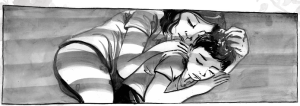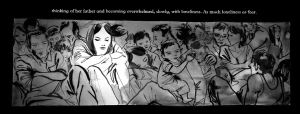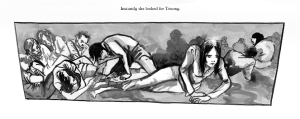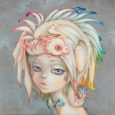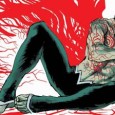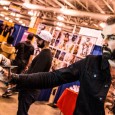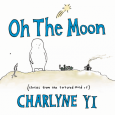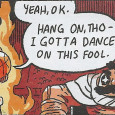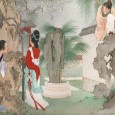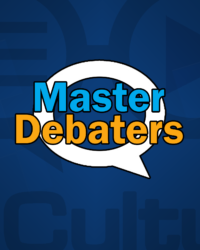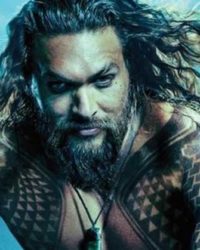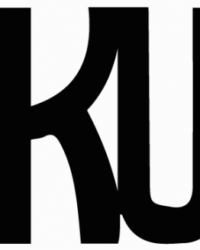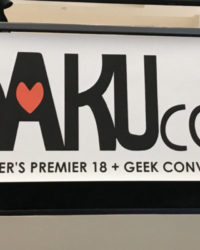By featuring traditional art by Matt Huynh as well as animation, sound effects, music, and video clips, the comic is not only a unique experience but an educational one. It is an example of an internet exclusive medium that needs to be looked at closer and utilized more for storytelling in the digital age. By adding interactive elements not unlike a computer game but still firmly rooted in its illustrative roots, you add additional atmosphere, immersion and context to the piece. A perfect intersection between mediums it allows easy audience (reader) engagement in a highly distractable culture in it’s ability to inform.
For “Artist Spotlight” we were not only able to view and experience this fantastic comic, but were also able to talk to Matt about the project and about his body of work as an artist.
I’m an illustrator and cartoonist from Sydney, but I’ve been living in Brooklyn the past few years. My work draws as much from South-East Asian ink painting as it does the Western superhero comics that I grew up on! I’ve worked across animation, performance, murals, packaging, advertising and editorial, but my first love was comics.
I’d love to do a superhero comic one day. Having that particular genre so saturated in the wider media today allows for greater subversion, particularly with playing in the toybox of existing worlds, characters and conventions. The breadth and possibility for content and voices in comics is much more exciting to me at the moment though.
I noticed while experiencing The Boat and then looking at your work on your website, you state that your style is informed by ink brush painting, or sumi-e and shodo. Where did those influences come from or what brought you to those art forms?
It snuck up on me a little! I grew up in a not-so-devout Buddhist household and although we weren’t very into ritual and ceremony, ink paintings and calligraphy were part of the hodgepodge household decor which I mostly ignored because I was immersed in Western comics as a kid. I taught myself how to draw by following the direction and weight of brush strokes across the pages of superhero comics. I grew up with a little bit of the stereotypical first generation parents’ emphasis upon academics and intellectual achievement, so when I started my little rebellious exploration of art and spirituality, I was introduced to the ideas of dharma art and brush art as meditative practice in local monasteries.
What do you enjoy doing most with your art?
There are ideas about putting ink onto the page as a joining of heaven (the blank page as a sea of expansive possibility or ‘ma’), earth (inspiration or thought) and human (the act). In other words, to be open, consciously and intellectually engaged, and physically energized and connected to making the work. Every stage is really integral and healthy to encourage other. Just physically keeping my drawing hand moving and my eye exercising keeps me out of my head enough to be open to discovering the unexpected. It helps to think through an idea on the page with the medium itself rather than coming up with an idea abstractly in my head about a hypothetical visual and trying to adapt it into physical ink on the page. Ultimately, pulling a brush balanced with ink is simply very sensually satisfying in the most direct way. It’s just animal hair, pulp, carbon and water!
SBS contacted me about adapting Nam Le’s story into an interactive comic. I usually don’t work from other people’s source material because comics can be such a laborious and engaging task, especially with such harrowing material. However, the content, artistry, influences, resources and collaborators enthusiastic to work on a comic that was progressive and innovative was a big incentive for me. Nam Le is an astute writer dealing with themes and a moment in history I am very personally engaged in, and working with the team at SBS offered a chance to work with top notch sound design, animation, production, archival footage and programming to take the presentation of comics online to a new level.Australia is also enforcing abhorrent and regressive asylum seeker and boat people policies that has made clear to me, and my peers, how lucky my parent’s generation were to have a government with a comparatively open hearted, empathetic and compassionate policy. It is urgent to bring stories of some of the most vulnerable people and characters back into a debate that is being told by big media outlets and political pr spin from a world away.
The leadership role of an artist is to be fearless. There’s overt censorship and then there’s the more insidious, subtle pressures that erode the confidence of young artists wishing to engage in humanitarian, activist and political issues. If an artist is worried about paying rent, they’re going to find it difficult to take a risk, speak out, or just draw attention to themselves. I would love to see more young artists and students represent their own stories and experiences in their work, including their client work. A lot of mainstream media feels regrettably forgettable and impersonal, the most obvious example being the lack of diverse roles and stories. I would loathe to think that myself as a daydreaming young aspiring artist, would grow up, finally become an artist, be in a position to communicate and work with a bigger megaphone, only to be afraid to speak up and show myself.
I’m very engaged with the act of making the work to transform myself, whether it is overtly investigating my personal history, looking at experiences from different angles, investigating and teaching myself more about communities or connecting with others by telling their stories to new audiences. Hopefully the artefact or evidence of that process is transformative for audiences too!Despite my best efforts, it’s difficult for me to depart from recurring themes of identity – particularly migration, abandonment, rebuilding, inexplicable loss and absence, race and power. These same ideas run under all my stories and art, whether they’re historical recounts or Gothic fiction, but working in different modes lets me grapple with these themes from new perspectives.For example, I did a comic about my parent’s time in a Malaysian refugee camp. Their recounts were always cursory and romanticized, making it difficult to look directly and objectively at a part of history they’ve long left in the past and aren’t eager to revisit, but it let me empathize with them, not least as a very young couple in love and learning to raise a family in extraordinary circumstances.Then I The Boat based on Nam Le’s short story. Having the benefit of another writer’s research and experience into the same moment in history and involving the same locations and even character types, let me look much more directly at a very personal part of my family’s identity with the benefit of being remove with ‘fiction’.
Would you like to do more interactive comics of this nature in the future?
I’d love to explore more with interactive comics, particularly with an original work created specifically for the digital space and this particular medium.The Boat presented such a huge challenge. It is already enough of a dilemma to adapt source material into the comics medium, but on top of that we had to research and design a new online presentation for comics from scratch, and then introduced disciplines beyond comics into the presentation – footage, animation and sound design. This project gave me a chance to explore the greatest boundaries of interactive and then make some choices about how to tell this one, particular story, but there are so many opportunities for story telling left on the table. We didn’t even use color!The opportunity to make work specifically designed for interactive comics itself, and free from source material, whether that’s history or an adaptation from another medium, would expand the possibilities for what a creator could do with interactive comics.I also toy with the idea of another adaptation, to make a work that is more about the transformation of the work itself. Where the point of the adaptation itself is its departure and possibility for change, rather than its similarities which can come across as a bit of a cerebral, tick-box exercise.
I’m currently working on some animation for rock concert projection, illustrating a short story collection, and putting together posters and projection for an arts festival! An exhibition and more writing is further down the pipeline, always being chipped away at.
Thank you to Matt Hyugh for taking the time to answer our questions. It was a huge honor.
Max Eber
Staff Writer
max@sub-cultured.com
@maxlikescomics


